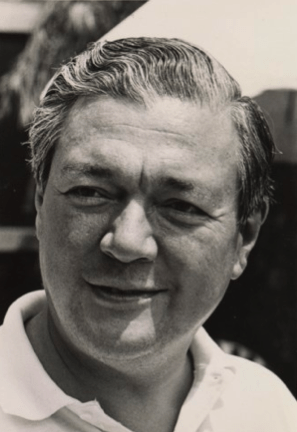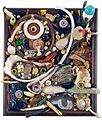Alfonso A. Ossorio facts for kids
Quick facts for kids
Alfonso A. Ossorio
|
|
|---|---|

Alfonso Ossorio 1916-1990
|
|
| Born |
Alfonso Angel Yangco Ossorio
August 2, 1916 Manila, Philippine Islands
|
| Died | December 5, 1990 (aged 74) New York City, New York, United States
|
| Nationality | Filipino American |
| Education | Harvard University, Rhode Island School of Design |
| Known for | Painting |
|
Notable work
|
The Angry Christ mural, Congregations series |
| Movement | Abstract expressionism |
Alfonso Angel Yangco Ossorio (August 2, 1916 – December 5, 1990) was a Filipino American abstract expressionist artist. He was born in Manila, Philippines, in 1916. His family was wealthy, with a mix of Hispanic, Filipino, and Chinese backgrounds.
Alfonso went to school in England from age eight to thirteen. When he was fourteen, he moved to the United States. He studied at Portsmouth Priory in Rhode Island, graduating in 1934. He then studied fine art at Harvard University from 1934 to 1938. Later, he continued his art studies at the Rhode Island School of Design. Ossorio became an American citizen in 1933. During World War II, he served in the United States Army as a medical illustrator, drawing pictures for medical purposes.
Contents
Alfonso Ossorio's Art Journey
Alfonso Ossorio's early artworks were in a style called surrealism. This art style often shows dreamlike or strange images. He admired and collected paintings by famous artists like Jackson Pollock. Ossorio even helped connect Pollock with a young gallery owner named Paul Facchetti from Paris. This led to Pollock's first solo art show in Europe in 1952. In the early 1950s, Ossorio began pouring oil and enamel paints onto his canvases. This was a style used by the first abstract expressionist artists in the United States.
The Angry Christ Mural
In 1950, Ossorio was asked to create a large painting for a church in Victorias City, Philippines. This painting is known as "The Angry Christ" mural. It is the main artwork in the St. Joseph the Worker Parish Church. The church was rebuilt by the Czech architect Antonín Raymond.
Ossorio spoke about this mural in 1968. He said it was like a "continual last judgment." He explained that the church was built so the sun would shine on the priest during services. The huge mural would be right behind the priest. Ossorio felt it worked perfectly. Even though people didn't like it much at first, it later became a very important place for visitors.
Exploring New Art Ideas
In 1950, Ossorio traveled to Paris to meet another artist named Jean Dubuffet. Dubuffet was interested in art brut. This term means "raw art" and refers to art made by people who haven't had formal art training. This could include art by people in mental hospitals or children. This idea opened up new ways of thinking for Ossorio. He found freedom in the natural, untrained creativity of these artists.
Following advice from Jackson Pollock, Ossorio bought a large estate called "The Creeks" in East Hampton in 1951. He lived there for over forty years. He even arranged to keep and show Dubuffet's art brut collection at his home.
Creating Congregations
In the 1950s, Ossorio started making artworks that looked like Dubuffet's assemblages. An assemblage is a piece of art made by putting together different found objects. Ossorio would attach all sorts of things to his art panels. He used shells, bones, driftwood, nails, dolls' eyes, cabinet knobs, dice, costume jewelry, pieces of mirror, and children's toys.
Ossorio called these artworks congregations. This word has a religious meaning, like a gathering of people. He felt that each object in his art was unique. He believed that all objects had life. By bringing together different, everyday items, he found a way to mix art and spirituality. He continued to create these unique congregations until he passed away in 1990.
In 1961, Ossorio's work was shown alongside Dubuffet and many other artists. This was part of a big exhibition at the Museum of Modern Art called The Art of Assemblage. This show helped introduce this type of art to many people.
Legacy and Collections
Alfonso Ossorio passed away in New York City in 1990. Half of his ashes were scattered at his beautiful estate, The Creeks. The other half were later placed at Green River Cemetery. Many other famous artists and writers are also buried there.
After Ossorio's death, his partner, Edward "Ted" Dragon, arranged for The Creeks to be sold. It was eventually bought by Ronald Perelman. The estate included many of Ossorio's brightly colored found object art sculptures. These were placed among the special evergreen trees that Ossorio had carefully planted in his last 20 years.
You can find Alfonso A. Ossorio's artworks in many public collections. These include the Harvard Art Museum in Massachusetts, the Honolulu Museum of Art, and the Housatonic Museum of Art in Connecticut. His work is also in Washington D.C. museums like The Phillips Collection, National Gallery of Art, and Smithsonian American Art Museum.
Images for kids
-
Alfonso A. Ossorio, Forearmed, mixed media assemblage, 1967


